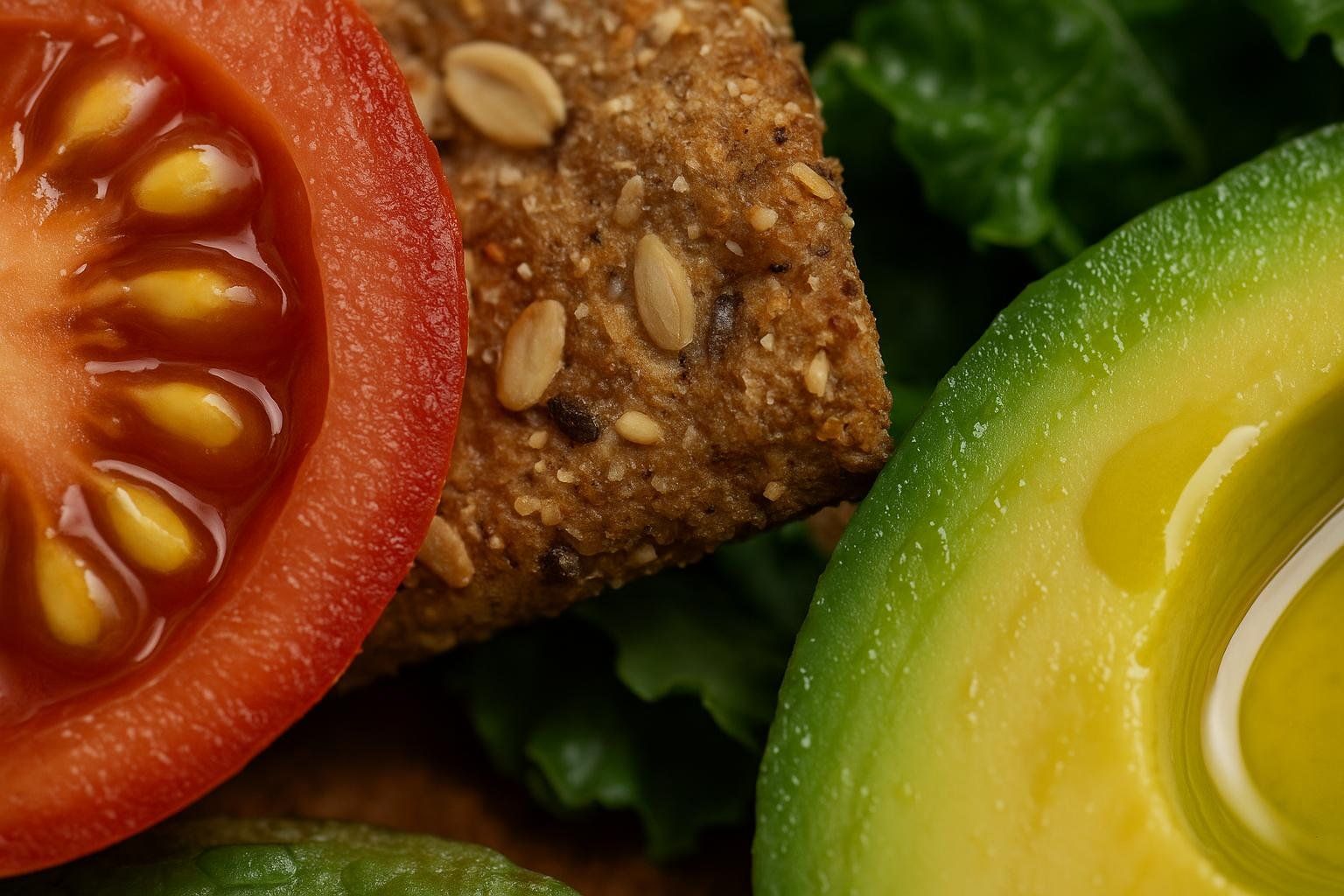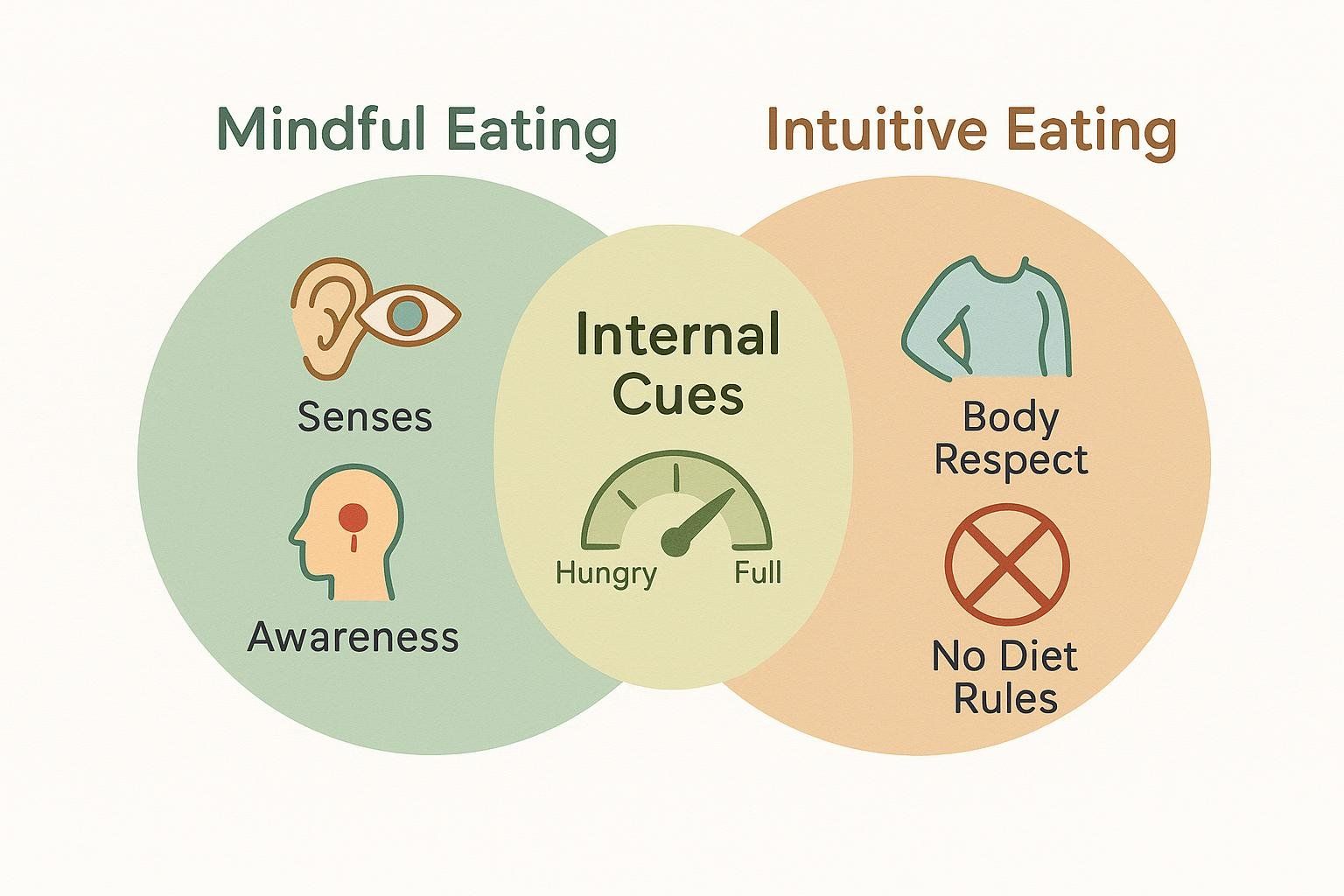What Is Mindful Eating?

What Is Mindful Eating? A Beginner's Guide
Mindful eating sounds simple—pay attention while you eat—but it can meaningfully reshape how you relate to food, hunger, and fullness. This guide explains what mindful eating is, the evidence behind it, and exactly how to practice it in real life, whether you’re busy, feeding a family, or seeking gentler digestion.
Defining Mindful Eating
Mindful eating is the practice of bringing nonjudgmental, present-moment awareness to food choices and the act of eating—tuning into hunger/fullness cues, senses, emotions, and environment. It’s not a diet or set of rules; it’s attention and curiosity applied to each bite and how it feels afterward (Harvard Nutrition Source).
Evidence-based benefits
Mindful eating is supported by leading institutions and a growing research base:

- Reduces binge and emotional eating and improves coping with cravings, with mixed effects on body weight overall (Harvard Nutrition Source).
- Improves diet quality (e.g., choosing fruits over sweets; smaller portions of calorie-dense foods) and supports more enjoyable meals (Harvard Nutrition Source).
- Helps you slow down so fullness signals can register, which may aid portion control and reduce indigestion (American Heart Association).
- Supports digestion by reducing distracted, rapid eating and encouraging thorough chewing (VA Whole Health Library).
- A systematic review and meta-analysis of 32 studies found that mindfulness-based programs improved several eating patterns linked to weight gain, including:
- Less eating in response to external cues (like ads or social pressure)
- Lower intake of sweets
- Better awareness of fullness
What mindful eating is not: a cure-all or a standalone medical treatment. It complements nutrition knowledge and, when appropriate, professional care (Harvard Nutrition Source).
How to practice: a simple 5-step framework
Use these steps for one meal or snack per day to start.
- Pause and check your hunger
- Ask: Am I physically hungry, or seeking comfort, stimulation, or a break? Naming the reason creates choice (Mass General).
- Set the stage (remove distractions)

- Sit, put your phone away, and choose a calm spot. Distraction fuels mindless eating; presence improves satisfaction (American Heart Association).
- Engage your senses

- Notice appearance, aroma, textures, sounds, and first flavors. This sensory scan deepens enjoyment and slows pace (Harvard Nutrition Source).
- Slow down and chew more than usual

- Put utensils down between bites. Chew thoroughly. Research shows that chewing more slowly and thoroughly can reduce how much you eat during a meal, as found in a 2018 controlled study.
- Stop at comfortable satisfaction
- Aim for “no longer hungry” rather than “stuffed.” Slowing down helps your brain register fullness so you can stop earlier (American Heart Association).
Pro tip: Don’t skip meals. Extreme hunger makes mindful choices harder (Harvard Nutrition Source).
10-minute mindful meal walkthrough
Try this walkthrough, adapted from guidance by Mass General and VA Whole Health Library:
- Minute 0–1: Take 2 slow breaths. Rate hunger (see tools below).
- Minute 1–2: Observe your food’s colors, aromas, textures.
- Minute 2–7: Eat in small bites. Put your utensil down between bites. Notice the first 3 flavor notes in each bite.
- Minute 7–8: Halfway pause. Re-rate hunger/fullness and decide if you want more.
- Minute 8–10: Finish to “comfortable” (not stuffed). Reflect: What did you notice?
Mindful Eating Tools You Can Use Today
Hunger–Fullness scale (print or screenshot)

Use before, during, and after eating.
- 1: Faint/dizzy with hunger
- 2: Very hungry; low energy, irritable
- 3: Hungry; ready to eat
- 4: Slightly hungry
- 5: Neutral
- 6: Lightly satisfied
- 7: Comfortably satisfied
- 8: Very full; heavy
- 9: Uncomfortably full
- 10: Stuffed; stomach pain
Aim to start around 3–4 and stop around 6–7 (American Heart Association).
Quick checklist
- Breathe ×2 before eating
- Rate hunger (1–10)
- Phone away for 5–10 minutes
- Notice 3 flavors/3 textures
- Utensil down between bites
- Stop at 6–7 fullness; reflect for 10 seconds
Hunger–Fullness Log (this week)
| Day/Meal | Start level | Stop level | Note |
|---|---|---|---|
| Day 1 lunch | 3 | 6 | Felt energized afterward |
| Day 2 dinner | 2 | 8 | Ate too fast; try utensil-down cue |
| Day 3 snack | 5 | — | Not hungry; chose tea + 10-min walk instead |
If your personal goals include weight management, you can pair these mindful skills with structured planning using our weight loss calculator.
Mindful eating for different needs

- Busy schedules: Anchor one meal per day as “phone-free,” chew thoroughly, and stop at 6–7 on the fullness scale. Even a 10-minute mindful lunch counts (American Heart Association).
- Family meals: Turn it into a senses game—who can name the most colors, textures, or flavors in this dish? Kids engage better through play (VA Whole Health Library).
- Gentler digestion: Sit, slow, and chew more than usual; take sips of water between bites; aim for meals that last ~20 minutes to support digestive comfort (VA Whole Health Library).
For more ideas, explore our companion article on mindful eating strategies.
Mindful eating vs. intuitive eating

These approaches overlap but aren’t identical.
- Mindful eating focuses on present-moment awareness of eating experiences, senses, thoughts, and feelings—often including gratitude and food origins (Harvard Nutrition Source).
- Intuitive Eating is a broader framework that emphasizes responding to hunger/fullness cues, rejecting diet rules, body respect, and coping with emotions without using food (Harvard Nutrition Source).
In practice, many people blend both—using mindfulness skills while honoring internal cues and basic nutrition.
FAQs
- Is mindful eating a diet? No. It’s a set of attention skills you can bring to any way of eating (Harvard Nutrition Source).
- How many chews per bite? There’s no magic number; simply slowing down and chewing more tends to reduce overall intake.
- Can mindful eating help with weight loss? It can reduce overeating and improve food choices, but weight change results vary. It works best alongside nutrition guidance and physical activity (Harvard Nutrition Source).
- Is mindful eating okay for kids? Age-appropriate activities (senses games, family meals without screens) can support healthy habits, but avoid pressure or food rules (VA Whole Health Library).
- I’m on a GLP-1 medication—does mindful eating still apply? Yes. Slower, smaller meals and attention to early fullness often pair well with these medications; coordinate with your clinician for nutrition targets.
- Is mindful eating a treatment for eating disorders? No. It can be supportive when guided by clinicians but is not a substitute for professional care (Harvard Nutrition Source).
Next steps

- Pick one daily “mindful meal” this week and use the 5-step framework.
- Screenshot the tools section for easy reference.
- If body-composition change is your goal, pair mindful eating with data-driven tracking and revisit your plan monthly. Our guides on gut health and visceral fat can help you connect the dots.
Mindful eating helps you eat with more intention and enjoyment—no rules required. Start small, stay curious, and let your observations (not willpower) guide what comes next.


